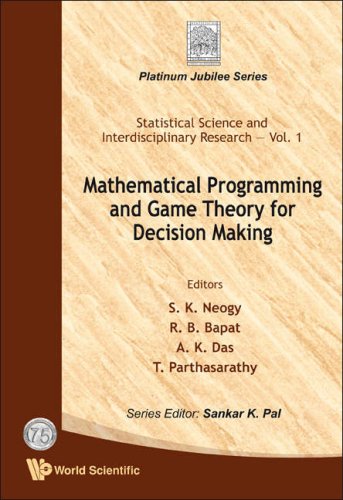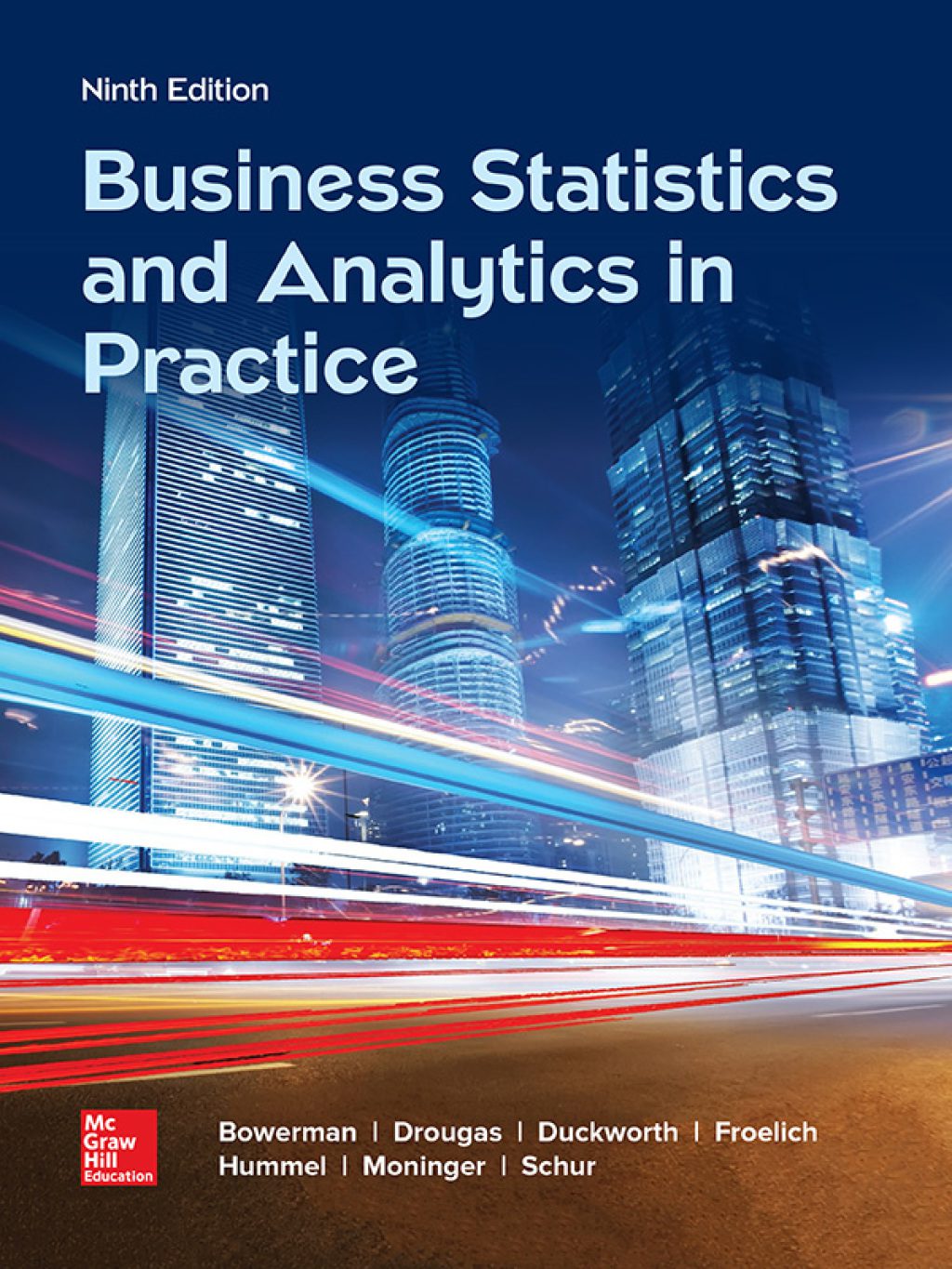S K Neogy, S. K. Neogy, R B Bapat, A K Das, T Parthasarathy9812813217, 9789812813213, 9789812813220
Contents: Mathematical Programming and Its Applications in Finance (L C Thomas); Anti-Stalling Pivot Rule for Linear Programs with Totally Unimodular Coefficient Matrix (S N Kabadi & A P Punnen); A New Practically Efficient Interior Point Method for Convex Quadratic Programming (K G Murty); A General Framework for the Analysis of Sets of Constraints (R Caron & T Traynor), Tolerance-Based Algorithms for the Traveling Salesman Problem (D Ghosh et al.); On the Membership Problem of the Pedigree Polytope (T S Arthanari); Exact Algorithms for a One-Defective Vertex Colouring Problem (N Achuthan et al.); Complementarity Problem Involving a Vertical Block Matrix and Its Solution Using Neural Network Model (S K Neogy et al.); Fuzzy Twin Support Vector Machines for Pattern Classification (R Khemchandani et al.); An Overview of the Minimum Sum of Absolute Errors Regression (S C Narula & J F Wellington); Hedging Against the Market with No Short Selling (S A Clark & C Srinivasan); Mathematical Programming and Electrical Network Analysis II: Computational Linear Algebra Through Network Analysis (H Narayanan); Dynamic Optimal Control Policy in Price and Quality for High Technology Product (A K Bardhan & U Chanda); Forecasting for Supply Chain and Portfolio Management (K G Murty); Variational Analysis in Bilevel Programming (S Dempe et al.); Game Engineering (R J Aumann); Games of Connectivity (P Dubey & R Garg); A Robust Feedback Nash Equilibrium in a Climate Change Policy Game (M Hennlock); De Facto Delegation and Proposer Rules (H Imai & K Yonezaki); The Bargaining Set in Effectivity Function (D Razafimahatolotra); Dynamic Oligopoly as a Mixed Large Game Toy Market (A Wiszniewska-Matyszkiel); On Some Classes of Balanced Games (R B Bapat); Market Equilibrium for Combinatorial Auctions and the Matching Core of Nonnegative TU Games (S Lahiri); Continuity, Manifolds, and Arrow s Social Choice Problem (K Saukkonen); On a Mixture Class of Stochastic Games with Ordered Field Property (S K Neogy).
Table of contents :
Contents……Page 18
Foreword……Page 6
Preface……Page 8
Acknowledgments……Page 16
Abstract……Page 22
1.2 Portfolio Optimization……Page 23
1.3 Asset-liability Models……Page 26
1.4 Yield Curves……Page 28
1.5 Credit Scorecards……Page 31
Bibliography……Page 34
2.1 Introduction……Page 36
2.2 Pivot Selection Rule……Page 38
Bibliography……Page 40
Abstract……Page 42
3.2 The Centering Strategy……Page 43
3.3 Descent Step Using a Descent Direction……Page 46
3.4 Descent Step Using the Touching Constraints……Page 47
3.5 The Algorithm……Page 48
3.6 Convergence Results……Page 49
3.7 The Case When the Matrix D is Not Positive Definite……Page 51
Bibliography……Page 52
Abstract……Page 54
4.1 Introduction……Page 55
4.2 The Set Covering Formulation……Page 56
4.3 Random Sampling……Page 60
Bibliography……Page 65
Abstract……Page 68
5.1 Introduction……Page 69
5.2.1 The Relaxed Assignment Problem……Page 70
5.2.3 The Contraction Procedure and a Greedy Algorithm……Page 71
5.3 Tolerance-based Greedy Algorithms……Page 72
5.4 Computational Experience……Page 74
5.5 Summary and Future Research Directions……Page 78
Bibliography……Page 79
Abstract……Page 82
6.1.1 Computational Complexity, Polytopes and Efficiency……Page 83
6.2 Preliminaries & Notations……Page 85
6.2.1 Rigid, Dummy arcs in a Capacited Transportation Problem……Page 87
6.2.2 Definition of the Pedigree Polytope……Page 89
6.2.3 Multistage Insertion and Related Results……Page 91
6.3 Polytopes and Efficiency……Page 93
6.3.0.1 Problems Related to Polytopes……Page 94
6.3.1 Properties of the Polytope, conv(An)……Page 95
6.4 Construction of the Layered Network N……Page 98
6.5 Necessity of Fk Feasibility for Membership……Page 102
6.6 Pedigree Packability……Page 107
6.7 A Multicommodity Flow Problem to Check Member- ship……Page 111
6.8 Computational Complexity of Checking the Necessary Condition……Page 116
6.9 Concluding Remarks……Page 117
Bibliography……Page 118
7.1 Introduction……Page 120
7.2 Sequential Colouring Heuristics for k-DVCP……Page 122
7.3 Implicit Enumeration Algorithms for 1–DVCP……Page 123
7.4 Computational Performance of the Algorithms……Page 128
Acknowledgement……Page 131
Bibliography……Page 132
8.1 Introduction……Page 134
8.2 Preliminaries……Page 136
8.3 Main Results……Page 139
8.4.1 Proposed Neural Network Dynamics……Page 146
8.5 Simulation Results……Page 147
Bibliography……Page 149
Abstract……Page 152
9.1 Introduction……Page 153
9.2 Support Vector Machines……Page 154
9.3 Twin Support Vector Machines……Page 155
9.4 Fuzzy Twin Support Vector Machines……Page 157
9.5 Experimental Results……Page 160
Bibliography……Page 162
Abstract……Page 164
10.1 Introduction……Page 165
10.2 Computational Algorithms……Page 168
10.3 Statistical Properties and Inference……Page 170
10.4 Variable Selection……Page 173
10.5 Coefficient of Determination……Page 174
10.6 Other Results……Page 175
10.7 Likelihood Displacement……Page 176
10.8 Robustness……Page 179
10.9 Multiple Criteria Linear Regression Using MSAE……Page 182
Bibliography……Page 183
Abstract……Page 190
11.1 Introduction……Page 191
11.2 Securities Market Model……Page 193
11.3 Fundamental Value……Page 196
11.4 Trading Strategies……Page 198
11.5 Hedging Prices……Page 200
Bibliography……Page 206
12.1 Introduction……Page 208
12.2 Electrical Network Analysis Procedures……Page 211
12.2.1 Nodal Analysis……Page 214
12.2.2 Loop Analysis……Page 217
12.2.3 Hybrid Analysis……Page 218
12.3 Experimental Results……Page 221
12.4 A Proposal……Page 223
12.5 Conclusion……Page 224
Appendix: A variation of PCG……Page 225
A.1 Modi ed CG……Page 227
A.2 Modi ed Preconditioned CG……Page 229
A.3 Justi cation for Modi ed Preconditioned CG……Page 230
Bibliography……Page 232
Abstract……Page 234
13.1 Introduction……Page 235
13.2 Dynamic Diffusion of Demand……Page 236
13.3 Model Development……Page 237
13.4 Dynamic Optimization……Page 240
13.6 Pricing and Quality Impact on Leapfrogging……Page 243
13.7 Optimal Introduction Timing Strategy for Second Generation Product……Page 245
A. Optimal Pricing……Page 247
B. Significance of Pricing and Quality in Leapfrogging……Page 248
C. Optimal Introduction Timing Strategy……Page 249
Bibliography……Page 250
14.1 Introduction……Page 252
14.2 Costs of High Inventories and Shortages……Page 253
14.3 Commonly used Techniques for Forecasting Demand……Page 254
14.4.1 Using Normal Distribution with updating of Ex- pected Value and Standard Deviation in each Period……Page 255
14.4.3 Using Distributions other than Normal……Page 256
14.5 A Nonparametric Method for Updating and Forecast- ing the Entire Demand Distribution……Page 258
14.6 An Application of the Forecasting Method of Section 14.5 for computing Optimal Order Quantities……Page 261
14.7 How to incorporate Seasonality in Demand into the Model……Page 265
14.8 Portfolio Management……Page 266
14.9 Variance as a Measure of Risk, and the Markovitz Model for Portfolio Optimization……Page 269
14.10 Other Measures of Risk for Portfolio Optimization……Page 270
14.11 Portfolio Management: Tracking the Distribution of Return from a Portfolio that is kept for a Long Time……Page 271
14.12 A Model based on Statistical Learning to nd an Op- timum Portfolio……Page 272
Bibliography……Page 274
15.1 Introduction……Page 278
15.2 Tools from Variational Analysis……Page 282
15.3 Partially Convex Lower-level Problems……Page 285
15.4 Fully Convex Lower-level Problems……Page 292
Bibliography……Page 297
16. Game Engineering R. J. Aumann……Page 300
Auctions:……Page 301
Arbitration:……Page 303
Traffic:……Page 304
17.1 Introduction……Page 308
17.2.1 Multicast Transmission……Page 310
17.2.2 Unicast Transmission……Page 311
17.2.4 Transmission of Information Partitions……Page 312
17.2.5 General Network with Controlled Edges……Page 313
17.3.2 Information……Page 314
17.3.5 The Transmission of Information……Page 315
17.3.6 The Reception of Information……Page 316
17.3.8 The Bene t from a Transmission……Page 317
17.6 Remarks……Page 318
17.7.1 Proof of Theorem 17.1……Page 321
Bibliography……Page 325
18.1 Introduction……Page 326
18.2 The Climate Models……Page 329
18.2.1 Climate Change Impacts……Page 330
18.3 Players and Payo s……Page 331
18.3.1 Investor i 2 [1; n]……Page 332
18.3.2 Policy Maker j 2 [1;N]……Page 335
18.3.3 Game Formulations……Page 339
18.4 Concluding Comments……Page 340
18.5 Summary……Page 343
18.6.1 Appendix A.1 Proof of Proposition 1……Page 344
18.6.2 Appendix A.2 Proof of Proposition 2……Page 345
Bibliography……Page 347
19.1 Introduction……Page 348
19.2 Model and Result……Page 350
19.3 Proof……Page 353
19.4 FO rule and Discussion……Page 356
Bibliography……Page 357
20.1 Introduction……Page 360
20.2 Definitions and Notations……Page 362
20.3 Some Analysis of Cycles……Page 364
20.4 Stability and Cycles……Page 372
20.4.1 Comparison of the Bargaining Sets……Page 373
20.4.2 The Zhou’s Bargaining Set……Page 374
20.4.3 The Mass-Colell’s Bargaining Set……Page 378
20.5 Annexe……Page 385
Bibliography……Page 389
21.1 Introduction……Page 390
21.1.1 Large Games……Page 391
21.2.1 Producers……Page 393
21.2.2 Parents (and Children)……Page 394
21.3 Results……Page 397
21.3.1 Case A: Two Periods with Dead-Season……Page 402
21.3.2 Case B: Two Periods……Page 403
21.3.3 Case C: Finitely Many Stages and Negligibility of Low Advertising Efforts……Page 404
21.3.4 Case D: In nite Time Horizon and Negligibility of Low Advertising Efforts……Page 407
Bibliography……Page 409
22.1 Introduction……Page 412
22.2 Regression Games……Page 413
22.3 Connectivity Games……Page 417
Bibliography……Page 420
23.1 Introduction……Page 422
23.2 Combinatorial Auctions……Page 425
23.3 Games with Transferable Utilities……Page 426
23.4 Games with Transferable Utilities as Combinatorial Auctions……Page 428
23.5 Market Equilibrium and Matching Cores……Page 431
23.6 Discussion……Page 432
Acknowledgements……Page 433
Bibliography……Page 434
24.1 Introduction……Page 436
24.2.1 Background……Page 439
24.2.2 Chickhilnisky’s Smooth Social Welfare Function……Page 441
24.2.3 Illustrations of the Framework……Page 444
24.2.4 Implications of the Manifold View……Page 446
24.3.1 Simple Arrow-type Social Choice System……Page 448
24.3.2 Market Mechanism and Welfare……Page 454
24.3.3 Voting……Page 458
24.3.4 Legislation……Page 461
24.3.5 Arrow’s Abstract Theory of Collective Decision Making……Page 464
24.4 Summary……Page 467
Bibliography……Page 468
Abstract……Page 472
25.1 Introduction……Page 473
25.2 Preliminaries……Page 478
25.3 Discounted Zero-sum SC/AR-AT Mixture Stochastic Game……Page 480
25.4 Undiscounted Zero-sum SC/AR-AT Mixture Stochas- tic Game……Page 486
Bibliography……Page 496







Reviews
There are no reviews yet.